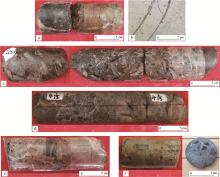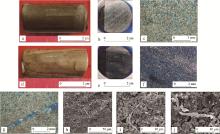

石油与天然气地质 ›› 2020, Vol. 41 ›› Issue (1): 83-91.doi: 10.11743/ogg20200108
刘永立1,2( ), 尤东华3, 高利君2, 张卫峰2, 谢乘飞2
), 尤东华3, 高利君2, 张卫峰2, 谢乘飞2
收稿日期:2019-08-26
出版日期:2020-02-01
发布日期:2020-01-19
第一作者简介:刘永立(1982-),男,硕士、副研究员,碳酸盐岩沉积与储层研究。E-mail:基金项目:
Yongli Liu1,2( ), Donghua You3, Lijun Gao2, Weifeng Zhang2, Chengfei Xie2
), Donghua You3, Lijun Gao2, Weifeng Zhang2, Chengfei Xie2
Received:2019-08-26
Online:2020-02-01
Published:2020-01-19
Supported by:摘要:
塔里木盆地下奥陶统蓬莱坝组普遍为局限台地相沉积,塔河地区最为典型,前期数口钻井已揭示塔河地区蓬莱坝组以中-厚层粉-细晶白云岩为主。而其西南部的塔深6井揭示蓬莱坝组岩性差异较大,主要为砾屑白云岩、深灰色角砾状硅质和浅灰色层状硅质岩组合,其中发育一套近60 m浅灰色层状硅质岩。通过岩心观察、常规岩矿、测井和地震相分析,识别出塔深6井蓬莱坝组沉积背景为局限台地内的局部负低洼区,南北长约300 m,东西宽约200 m,台洼高差可达上百米,发生滑塌而产生角砾状硅质和砾屑白云岩的混杂堆积,并形成浅水造硅生物建造的均匀层状硅质岩,不同于周边典型的局限台地厚层白云岩组合。层状硅质岩具有中孔、低渗特征,储集空间主要为直径1~6 μm的密集微孔,见菌丝等古微生物痕迹。由此,确定塔深6井蓬莱坝组硅质岩主要为由沉积地形诱发的机械垮塌破碎和浅水-半深水生物成因,对于丰富和深化塔里木盆地奥陶系沉积演化和储层成因具有重要意义。
中图分类号:

图4
塔河油田塔深6井蓬莱坝组典型硅质团块(a,b)和角砾状硅质岩(c—f)岩心照片及岩石薄片照片 a.深灰色硅质团块,黄灰色灰质白云岩,被高角度构造裂缝切割,方解石全充填,埋深7 440.00~7 440.22 m;b.隐晶质硅质,微裂缝发育,埋深7 440.00 m;c.浅灰色不规则角砾状硅质,杂乱分布,无分选,埋深7 441.94~7 442.34 m;d.深灰色角砾状硅质岩,上部为点接触,之间充填方解石,下部呈长条状或竹叶状,嵌入式分布于基岩中,杂乱分布,埋深7 524.63~7 524.92 m;e.灰色粉细晶砾屑白云岩,局部夹深灰色不规则角砾状硅质,杂乱分布,无分选,埋深7 690.40~7 690.47 m;f.井壁取心,灰色粉细晶白云岩,夹深灰色角砾状硅质,埋深7 716.48 m "


图5
塔河油田塔深6井蓬莱坝组典型均匀层状硅质岩心照片(井壁取心)及其显微特征照片 a.硅质岩,久置原油外渗,埋深7 547.47 m;b.铸体薄片照片重构,微孔顺层分布,埋深7 547.47 m;c.微孔发育,面孔率20%,浸染状,埋深7 547.47 m;d.层状硅质岩,原油外渗,埋深7 561.49 m;e.铸体薄片照片重构,微孔顺层分布,埋深7 561.49 m;f.微孔发育,面孔率20%,浸染状,埋深7 561.49 m; g.硅质岩,微孔、裂缝状溶孔发育,孔隙度为12.3%,渗透率为0.09×10-3 μm2,埋深7 576.71 m;h.硅质岩,微孔发育,见微生物菌丝,埋深7 576.71 m,;i.硅质岩,微孔发育,见微生物菌丝,埋深7 576.71 m;j.硅质岩,微孔发育,见微生物菌丝,埋深7 576.71 m "

| 1 | 冯增昭, 鲍志东, 吴茂炳, 等. 塔里木地区寒武纪和奥陶纪岩相古地理[M]. 北京: 地质出版社, 2005: 1- 179. |
| Feng Zengzhao , Bao Zhidong , Wu Maobing , et al. Lithofacies Paleogeography of Cambrian and Ordovician of Tarim[M]. Beijing: Geological Publishing House, 2005: 1- 179. | |
| 2 | 许效松, 刘宝珺, 牟传龙, 等. 中国中西部海相盆地分析与油气资源[M]. 北京: 地质出版社, 2005: 41- 118. |
| Xu Xiaosong , Liu Baojun , Mou Chuanlong , et al. Analysis on marine basins and oil & gas resources in central and western China[M]. Beijing: Geological Publishing House, 2005: 41- 118. | |
| 3 |
高志前, 樊太亮, 焦志峰, 等. 塔里木盆地寒武-奥陶系碳酸盐岩台地样式及其沉积响应特征[J]. 沉积学报, 2006, 24 (1): 19- 27.
doi: 10.3969/j.issn.1000-0550.2006.01.003 |
|
Gao Zhiqian , Fan Tailiang , Jiao Zhifeng , et al. The structural types and depositional characteristics of carbonate platform in the Cambrian-Ordovician of Tarim Basin[J]. Acta Sedimentologica Sinica, 2006, 24 (1): 19- 27.
doi: 10.3969/j.issn.1000-0550.2006.01.003 |
|
| 4 |
熊冉, 张天付, 乔占峰, 等. 塔里木盆地奥陶系蓬莱坝组碳酸盐岩缓坡沉积特征及油气勘探意义[J]. 沉积与特提斯地质, 2019, 39 (1): 42- 49.
doi: 10.3969/j.issn.1009-3850.2019.01.005 |
|
Xiong Ran , Zhang Tianfu , Qiao Zhanfeng , et al. The carbonate ramp deposits from the Ordovician Penglaiba Formation in the Tarim Basin, Xinjiang:Sedimentary characteristics and their implications for petroleum exploration[J]. Sedimentary Geology and Tethyan Geology, 2019, 39 (1): 42- 49.
doi: 10.3969/j.issn.1009-3850.2019.01.005 |
|
| 5 | 李庆, 胡文瑄, 张军涛, 等. 塔里木盆地西北缘中寒武统硅质岩特征与形成环境[J]. 矿物学报, 2010, 30 (3): 293- 303. |
| Li Qing , Hu Wenxuan , Zhang Juntao , et al. Petrological and geoche-mical characteristics of chert from the Middle Cambrian in the Tarim Basin and its implication for sedimentary and tectonic environments[J]. Acta Mineralogica Sinica, 2010, 30 (3): 293- 303. | |
| 6 | 杨程宇, 李美俊, 倪智勇, 等. 塔里木盆地西北缘玉尔吐斯组硅质岩成因及石油地质意义[J]. 沉积学报, 2016, 34 (4): 653- 661. |
| Yang Chengyu , Li Meijun , Ni Zhiyong , et al. Siliceous rock origin and significance in the Uyirtus Formation, northwestern margin of Tarim Basin[J]. Acta Sedimentologica Sinica, 2016, 34 (4): 653- 661. | |
| 7 | 杨宗玉, 罗平, 刘波, 等. 塔里木盆地阿克苏地区下寒武统玉尔吐斯组硅质岩分类及成因[J]. 地学前缘, 2017, 24 (5): 245- 264. |
| Yang Zongyu , Luo Ping , Liu Bo , et al. Analysis of petrological characteristics and origin of siliceous rocks during the earliest Cambrian Yurtus Formation in the Aksu area of the Tarim Basin in Northwest China[J]. Earth Science Frontiers, 2017, 24 (5): 245- 264. | |
| 8 |
杨瑞东, 张传林, 罗新荣, 等. 新疆库鲁克塔格地区早寒武世硅质岩地球化学特征及其意义[J]. 地质学报, 2006, 80 (4): 598- 605.
doi: 10.3321/j.issn:0001-5717.2006.04.014 |
|
Yang Ruidong , Zhang Chuanlin , Luo Xinrong , et al. Geochemical characteristics of Early Cambrian cherts in Quruqtagh, Xinjiang, West China[J]. Acta Geologica Sinica, 2006, 80 (4): 598- 605.
doi: 10.3321/j.issn:0001-5717.2006.04.014 |
|
| 9 | 陈永权, 蒋少涌, 周新源, 等. 塔里木盆地寒武系层状硅质岩与硅化岩的元素、δ30Si、δ18O地球化学研究[J]. 地球化学, 2010, 39 (2): 159- 170. |
| Chen Yongquan , Jiang Shaoyong , Zhou Xinyuan , et al. δ30Si, δ18O and elements geochemistry on the bedded siliceous rocks and cherts in dolostones from Cambrian strata, Tarim Basin[J]. Geochimica, 2010, 39 (2): 159- 170. | |
| 10 |
朱东亚, 孟庆强. 塔里木盆地下古生界碳酸盐岩中硅化作用成因[J]. 石油实验地质, 2010, 32 (4): 358- 361.
doi: 10.3969/j.issn.1001-6112.2010.04.010 |
|
Zhu Dongya , Meng Qingqiang . The genesis of silicification in the Lower Paleozoic carbonate in the Tarim Basin[J]. Petroleum Geology and Experiment, 2010, 32 (4): 358- 361.
doi: 10.3969/j.issn.1001-6112.2010.04.010 |
|
| 11 | 李映涛, 叶宁, 袁晓宇, 等. 塔里木盆地顺南4井中硅化热液的地质与地球化学特征[J]. 石油与天然气地质, 2015, 36 (6): 934- 944. |
| Li Yingtao , Ye Ning , Yuan Xiaoyu , et al. Geological and geochemical characteristics of silicified hydrothermal fluids in Well Shunnan 4, Tarim Basin[J]. Oil & Gas Geology, 2015, 36 (6): 934- 944. | |
| 12 | 洪才均, 康仁东, 韩俊, 等. 跃进地区奥陶系硅质岩地球化学特征及成因研究[J]. 新疆地质, 2018, 36 (2): 239- 245. |
| Hong Caijun , Kang Rendong , Han Jun , et al. Geochemical characte-ristics and origin of the Ordovician siliceous rocks in Yuejin region[J]. Xinjiang Geology, 2018, 36 (2): 239- 245. | |
| 13 | 袁雪君, 张智礼, 孟凡巍, 等. 塔里木盆地YJ1X井中奥陶统一间房组燧石结核中的有机壁微体化石[J]. 微体古生物学报, 2019, 36 (1): 57- 69. |
| Yuan Xuejun , Zhang Zhili , Meng Fanwei , et al. Microbody organic-walled microfossils in nodular cherts from the Middle Ordovician Yijianfang Formation, Well YJ1X, Tarim Basin, China[J]. Acta Micropalaeontologica Sinica, 2019, 36 (1): 57- 69. | |
| 14 | 傅恒, 韩建辉, 孟万斌, 等. 塔里木盆地塔中北坡奥陶系碳酸盐岩岩溶储层的形成机理[J]. 天然气工业, 2017, 37 (3): 25- 36. |
| Fu Heng , Han Jianhui , Meng Wanbin , et al. Forming mechanism of the Ordovician karst carbonate reservoirs on the northern slope of central Tarim Basin[J]. Natural Gas Industry, 2017, 37 (3): 25- 36. | |
| 15 |
陆朋朋, 罗平, 阳正熙, 等. 柯坪断隆寒武-奥陶系硅质岩特征及储层分析[J]. 新疆地质, 2012, 30 (3): 329- 334.
doi: 10.3969/j.issn.1000-8845.2012.03.018 |
|
Lu Pengpeng , Luo Ping , Yang Zhengxi , et al. The petrology characte-ristics, sedimentology and reservoir analysis of Cambrian-Ordovician siliceous rocks in Kalpin Fault-Uplift[J]. Xinjiang Geology, 2012, 30 (3): 329- 334.
doi: 10.3969/j.issn.1000-8845.2012.03.018 |
|
| 16 | 焦方正, 翟晓先. 海相碳酸盐岩非常规大油气田——塔河油田勘探研究与实践[M]. 北京: 石油工业出版社, 2008: 140- 152. |
| Jiao Fangzheng , Zhai Xiaoxian . A unconventional large oil and gas field of marine carbonate rock:Exploration research and practice of Tahe oil field[M]. Beijing: Petroleum Industry Press, 2008: 140- 152. | |
| 17 |
刘存革, 刘树根, 李国蓉, 等. 塔里木盆地北部寒武系大型进积型台地-斜坡地震层序、演化与控制因素[J]. 地质学报, 2016, 90 (4): 669- 687.
doi: 10.3969/j.issn.0001-5717.2016.04.006 |
|
Liu Cunge , Liu Shugen , Li Guorong , et al. Seismic sequences, evolution and control factors of large Cambrian progradational platform-slope system in the northern Tarim Basin, Northwest China[J]. Acta Geologica Sinica, 2016, 90 (4): 669- 687.
doi: 10.3969/j.issn.0001-5717.2016.04.006 |
|
| 18 | 刘宝珺. 沉积岩石学[M]. 北京: 石油工业出版社, 1980: 192- 322. |
| Liu Baojun . Sedimentary petrology[M]. Beijing: Petroleum Industry Press, 1980: 192- 322. | |
| 19 | 曾允孚, 夏文杰. 沉积岩石学[M]. 北京: 石油工业出版社, 1986: 158- 198. |
| Zeng Yunfu , Xia Wenjie . Sedimentary petrology[M]. Beijing: Petroleum Industry Press, 1986: 158- 198. | |
| 20 | 高阳, 刘春, 白晓佳, 等. 自生"加大"含铁白云石胶结物特征及对致密砂岩储层的影响-以鄂尔多斯盆地陇东地区延长组4+5段为例[J]. 石油与天然气地质, 2019, 40 (5): 1066- 1073. |
| Gao Yang , Liu Chun , Bai Xiaojia , et al. Cement characteristics of overgrown authigenic ferron dolomite and its impact on tight sandstone reservoirs qualities:Case study of the Chang 4 & 5 members of Triassic YanchangFormation in Longdong area, Ordos Basin[J]. Oil & Gas Geology, 2019, 40 (5): 1066- 1073. | |
| 21 | Maliva R G , Siever R . Diagenetic replacement controlled by force of crystallization[J]. Geology, 1988, 16 (17): 688- 691. |
| 22 |
Maliva R G , Siever R . Nodular chert formation in carbonate rocks[J]. Journal of Geology, 1989, 97 (4): 421- 433.
doi: 10.1086/629320 |
| 23 | Rogers P J , Longman W M . An introduction to chert reservoirs of North America[J]. AAPG Bulletin, 2001, 85 (1): 1- 5. |
| 24 | Watney L W , Guy J W , Byrnes P A . Characterization of the Mississippian Osage Chat in South-Central Kansas[J]. AAPG Bulletin, 2001, 85 (1): 85- 113. |
| 25 | Rogers M S . Deposition and diagenesis of Mississippian chat reservoirs, north-central Oklahoma[J]. AAPG Bulletin, 2001, 85 (1): 115- 129. |
| 26 | 柴方圆. 下扬子下古生界沉积相研究及有利区评价[J]. 油气藏评价与开发, 2019, 9 (2): 701- 715. |
| Chai Fangyuan . Study on Paleozoic sedimentary facies and favorable area evaluation in lower Yangtze basin[J]. Reservoir Evaluation and Development, 2019, 9 (2): 701- 715. | |
| 27 | 贾振远, 李之琪. 碳酸盐岩沉积相和沉积环境[M]. 武汉: 中国地质大学出版社, 1989: 45- 58. |
| Jia Zhenyuan , Li Zhiqi . Carbonate sedimentary facies and sedimentary environment[M]. Wuhan: China University of Geosciences Press, 1989: 45- 58. | |
| 28 | 马永生, 梅冥相, 陈小兵, 等. 碳酸盐岩储层沉积学[M]. 北京: 地质出版社, 1999: 70- 101. |
| Ma Yongsheng , Mei Mingxiang , Chen Xiaobing , et al. Carbonate reservoir sedimentology[M]. Beijing: Geological Publishing House, 1999: 70- 101. | |
| 29 | 王清龙, 韩剑发, 李浩, 等. 塔里木盆地西北缘露头区中-下奥陶统碳酸盐岩层序结构、沉积演化及海平面变化[J]. 石油与天然气地质, 2019, 40 (4): 835- 916. |
| Wang Qinglong , Han Jianfa , Li Hao , et al. Carbonate sequence architecture, sedimentary evolution and sea level fluctuation of the Middle and Lower Ordovician on outcrops at the northwestern margin of Tarim Basin[J]. Oil & Gas Geology, 2019, 40 (4): 835- 916. | |
| 30 | 刘红光, 刘波, 曹鉴华, 等. 塔里木盆地玉北地区中-下奥陶统储层发育特征及控制因素[J]. 石油与天然气地质, 2018, 39 (1): 107- 118. |
| Liu Hongguang , Liu Bo , Cao Jianhua , et al. Characteristics and controlling factors of Lower-Middle Ordovician reservoirs in Yubei area, Tarim Basin[J]. Oil & Gas Geology, 2018, 39 (1): 107- 118. |
| [1] | 韩鹏远, 丁文龙, 杨德彬, 张娟, 马海陇, 王生晖. 塔里木盆地塔河油田S80走滑断裂发育特征及其对奥陶系储层的控制作用[J]. 石油与天然气地质, 2024, 45(3): 770-786. |
| [2] | 张艳秋, 陈红汉, 王燮培, 王彭, 苏丹梅, 谢舟. 塔里木盆地富满油田走滑断裂带通源性评价[J]. 石油与天然气地质, 2024, 45(3): 787-800. |
| [3] | 丁文龙, 李云涛, 韩俊, 黄诚, 王来源, 孟庆修. 碳酸盐岩储层高精度构造应力场模拟与裂缝多参数分布预测方法及其应用[J]. 石油与天然气地质, 2024, 45(3): 827-851. |
| [4] | 曹自成, 云露, 漆立新, 李海英, 韩俊, 耿锋, 林波, 陈菁萍, 黄诚, 毛庆言. 塔里木盆地顺北地区顺北84X井超千米含油气重大发现及其意义[J]. 石油与天然气地质, 2024, 45(2): 341-356. |
| [5] | 杨德彬, 鲁新便, 鲍典, 曹飞, 汪彦, 王明, 谢润成. 塔里木盆地北部奥陶系海相碳酸盐岩断溶体油藏成因类型及特征再认识[J]. 石油与天然气地质, 2024, 45(2): 357-366. |
| [6] | 张长建, 杨德彬, 蒋林, 姜应兵, 昌琪, 马雪健. 塔里木盆地塔河北部“过溶蚀残留型”断溶体发育特征及其成因[J]. 石油与天然气地质, 2024, 45(2): 367-383. |
| [7] | 江同文, 邓兴梁, 曹鹏, 常少英. 塔里木盆地富满断控破碎体油藏储集类型特征与注水替油效果[J]. 石油与天然气地质, 2024, 45(2): 542-552. |
| [8] | 牛月萌, 韩俊, 余一欣, 黄诚, 林波, 杨帆, 余浪, 陈俊宇. 塔里木盆地顺北西部地区火成岩侵入体发育特征及其与断裂耦合关系[J]. 石油与天然气地质, 2024, 45(1): 231-242. |
| [9] | 张三, 金强, 史今雄, 胡明毅, 段梦悦, 李永强, 张旭栋, 程付启. 塔北地区奥陶系地下河溶洞充填规律与储集性能[J]. 石油与天然气地质, 2023, 44(6): 1582-1594. |
| [10] | 康志江, 张冬梅, 张振坤, 王睿奇, 姜文斌, 刘坤岩. 深层缝洞型油藏井间连通路径智能预测技术[J]. 石油与天然气地质, 2023, 44(5): 1290-1299. |
| [11] | 胡伟, 徐婷, 杨阳, 伦增珉, 李宗宇, 康志江, 赵瑞明, 梅胜文. 塔里木盆地超深油气藏流体相行为变化特征[J]. 石油与天然气地质, 2023, 44(4): 1044-1053. |
| [12] | 张坦, 姚威, 赵永强, 周雨双, 黄继文, 范昕禹, 罗宇. 塔里木盆地巴麦地区石炭系卡拉沙依组年代标尺及地层剥蚀厚度精细计算[J]. 石油与天然气地质, 2023, 44(4): 1054-1066. |
| [13] | 郭宏辉, 冯建伟, 赵力彬. 塔里木盆地博孜—大北地区被动走滑构造特征及其对裂缝发育的控制作用[J]. 石油与天然气地质, 2023, 44(4): 962-975. |
| [14] | 李斌, 赵星星, 邬光辉, 韩剑发, 关宝珠, 沈春光. 塔里木盆地塔中Ⅱ区奥陶系油气差异富集模式[J]. 石油与天然气地质, 2023, 44(2): 308-320. |
| [15] | 张红波, 周雨双, 沙旭光, 邓尚, 沈向存, 姜忠正. 塔里木盆地顺北5号走滑断裂隆起段发育特征与演化机制[J]. 石油与天然气地质, 2023, 44(2): 321-334. |
| 阅读次数 | ||||||
|
全文 |
|
|||||
|
摘要 |
|
|||||